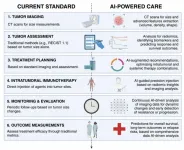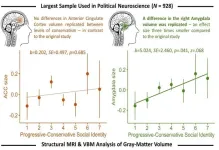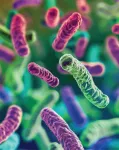(Press-News.org) Science has provided more than sufficient evidence to inform a collective and global approach to tackle the continued spread of plastic pollution, according to a new report.
Writing in the journal Science, an international group of experts say the need for worldwide action to tackle all forms of plastic and microplastic debris has never been more pressing.
It is clear that existing national legislation alone is insufficient to address the challenge, they say, and the United Nations’ Plastic Pollution Treaty – which will undergo its fifth round of deliberations in November 2024 – presents a “tangible opportunity” for joined-up international action.
However, for such a treaty to be truly effective it needs to commit to an overall reduction in plastic production alongside measures to reduce the emission and release of microplastic particles along the entire plastics life cycle. Failing to do so, the researchers add, could bring “a high risk of irreversible environmental damage”.
The article was written to mark the 20th anniversary of the first ever study, also published in the journal Science, to coin the term microplastics to describe the microscopic fragments of plastics in our ocean.
Both studies were led by Professor Richard Thompson OBE FRS, Head of the International Marine Litter Research Unit at the University of Plymouth, and a co-coordinator of the Scientists Coalition for an Effective Plastics Treaty.
It was co-authored by experts in marine biology, sustainability, environmental psychology, global plastics policy, and risk assessment, from: University of Plymouth, University of Bangor (UK); EA – Earth Action (Switzerland); University of Vienna (Austria); University of Wollongong (Australia); and Wageningen University (Netherlands).
Professor Thompson said: “After 20 years of research there is clear evidence of harmful effects from microplastic pollution on a global scale. That includes physical harm to wildlife, harm to societies and cultures, and a growing evidence base of harm to humans. Added to that is the fact that microplastics are persistent contaminants, and once in the environment they are virtually impossible to remove. There are still unknowns, but during the 20 years since our first study the amount of plastic in our oceans has increased by around 50%, only further emphasising the pressing need for action.”
Since the publication of the first study in 2004, an estimated 7,000 research studies have been conducted on microplastics, providing considerable evidence in their sources and impacts as well as potential solutions.
Microplastics have been found on every corner of the planet, in more than 1,300 aquatic and terrestrial species, in the food and drink we consume, and in multiple tissues and organs of the human body.
With emissions of microplastics to the environment estimated to be up to 40 megatonnes per year, a number that could double by 2040, predictions indicate the potential for widescale environmental harm moving into the next century.
Professor Sabine Pahl, Professor of Urban and Environmental Psychology at the University of Vienna and Honorary Professor at the University of Plymouth, added: “Plastic pollution is completely caused by human actions. That’s why we need research on perceptions of risks and benefits of plastic as well as other drivers of policy support and change, integrating a social science perspective.”
END
Scientists say we have enough evidence to agree global action on microplastics
2024-09-19
ELSE PRESS RELEASES FROM THIS DATE:
485 million-year temperature record of Earth reveals Phanerozoic climate variability
2024-09-19
Estimating past global temperature is important for understanding the history of life on Earth and for predicting future climate. Now, a new reconstruction of Earth’s temperature history over the past 485 million years – based on a method that combines diverse physical proxy data with climate model predictions – reveals a much wider range of climate variability across the Phanerozoic eon than previously understood. The findings highlight atmospheric carbon dioxide (CO2) as the dominant factor controlling climate variability throughout this period, offering new ...
Atmospheric blocking slows ocean-driven glacier melt in Greenland
2024-09-19
Cooling in the subsurface waters beneath Greenland’s Nioghalvfjerdsfjorden Glacier (79NG) from 2018 to 2021 was driven by European atmospheric blocking, which forced changes in the large-scale ocean circulation of the Nordic seas, researchers report, slowing glacial melt, despite ongoing global warming trends. The findings highlight the importance of regional atmospheric dynamics in influencing glacier stability. Understanding these dynamics is key to predicting the future of glaciers like ...
Study: Over nearly half a billion years, Earth’s global temperature has changed drastically, driven by carbon dioxide
2024-09-19
Published in the journal Science, the study presents a curve of global mean surface temperature that reveals Earth's temperature has varied more than previously thought over much of the Phanerozoic Eon a period of geologic time when life diversified, populated land and endured multiple mass extinctions. The curve also confirms Earth's temperature is strongly correlated to the amount of carbon dioxide in the atmosphere.
The start of the Phanerozoic Eon 540 million years ago is marked by the Cambrian ...
Clinical trial could move the needle in traumatic brain injury
2024-09-19
FOR IMMEDIATE RELEASE
Subscribe to UCSF News
Department of Defense-funded study aims to end a decades-long impasse in treatment development.
Traumatic brain injury (TBI) results in close to 70,000 deaths in the United States every year, and it is the cause of long-term physical, cognitive and mental disability in 5 million Americans. But despite three decades of work, treatments are sorely lacking.
Now, an innovative drug development trial will be available in emergency departments of 18 level 1 trauma sites nationwide. It is launched by UC San Francisco and the Transforming Research and Clinical Knowledge in Traumatic ...
AI model can reveal the structures of crystalline materials
2024-09-19
For more than 100 years, scientists have been using X-ray crystallography to determine the structure of crystalline materials such as metals, rocks, and ceramics.
This technique works best when the crystal is intact, but in many cases, scientists have only a powdered version of the material, which contains random fragments of the crystal. This makes it more challenging to piece together the overall structure.
MIT chemists have now come up with a new generative AI model that can make it much easier to determine the structures of these powdered crystals. The prediction model could help researchers characterize ...
MD Anderson Research Highlights for September 19, 2024
2024-09-19
HOUSTON ― The University of Texas MD Anderson Cancer Center’s Research Highlights showcases the latest breakthroughs in cancer care, research and prevention. These advances are made possible through seamless collaboration between MD Anderson’s world-leading clinicians and scientists, bringing discoveries from the lab to the clinic and back.
Genetic factors underscore disparities in colorectal cancer survival
Patients with colorectal cancer have varied overall survival, but it remains unclear how the frequency of certain gene mutations among different racial and ethnic groups influences outcomes. To investigate, researchers led by John Paul Shen, M.D., and ...
The role of artificial intelligence in advancing intratumoral immunotherapy
2024-09-19
“We explore how integrating these technologies could revolutionize personalized oncology.”
BUFFALO, NY- September 19, 2024 – A new editorial was published in Oncotarget's Volume 15 on September 17, 2024, entitled, “The emerging role of AI in enhancing intratumoral immunotherapy care.”
As highlighted in the abstract of this editorial, the emergence of immunotherapy (IO), and more recently, intratumoral IO, offers a novel approach to cancer treatment. This method enhances immune responses, allows for combination therapies, and helps reduce systemic adverse events. These techniques aim to ...
Political ideology is associated with differences in brain structure, but less than previously thought
2024-09-19
Conservative voters have slightly larger amygdalas than progressive voters—by about the size of a sesame seed. In a replication study publishing September 19 in the Cell Press journal iScience, researchers revisited the idea that progressive and conservative voters have identifiable differences in brain morphology, but with a 10x larger and more diverse sample size than the original study. Their results confirmed that the size of a person’s amygdala is associated with their political views but failed to find a consistent association between politics and the anterior cingulate cortex (ACC). Anatomical differences in both ...
Genetic tracing at the Huanan Seafood market further supports COVID animal origins
2024-09-19
A new international collaborative study provides a list of the wildlife species present at the market from which SARS-CoV-2, the virus responsible for the COVID-19 pandemic, most likely arose in late 2019. The study is based on a new analysis of metatranscriptomic data released by the Chinese Center for Disease Control and Prevention (CDC). The data come from more than 800 samples collected in and around the Huanan Seafood Wholesale market beginning on January 1, 2020, and from viral genomes reported from early COVID-19 patients. The research appears September 19 in the journal Cell.
“This is one of the most ...
Breastfeeding is crucial to shaping infant’s microbes and promoting lung health
2024-09-19
Human breast milk regulates a baby’s mix of microbes, or microbiome, during the infant’s first year of life. This in turn lowers the child’s risk of developing asthma, a new study shows.
Led by researchers at NYU Langone Health and the University of Manitoba, the study results showed that breastfeeding beyond three months supports the gradual maturation of the microbiome in the infant’s digestive system and nasal cavity, the upper part of the respiratory tract. Conversely, stopping breastfeeding earlier than three months disrupts the paced development of the microbiome and ...



